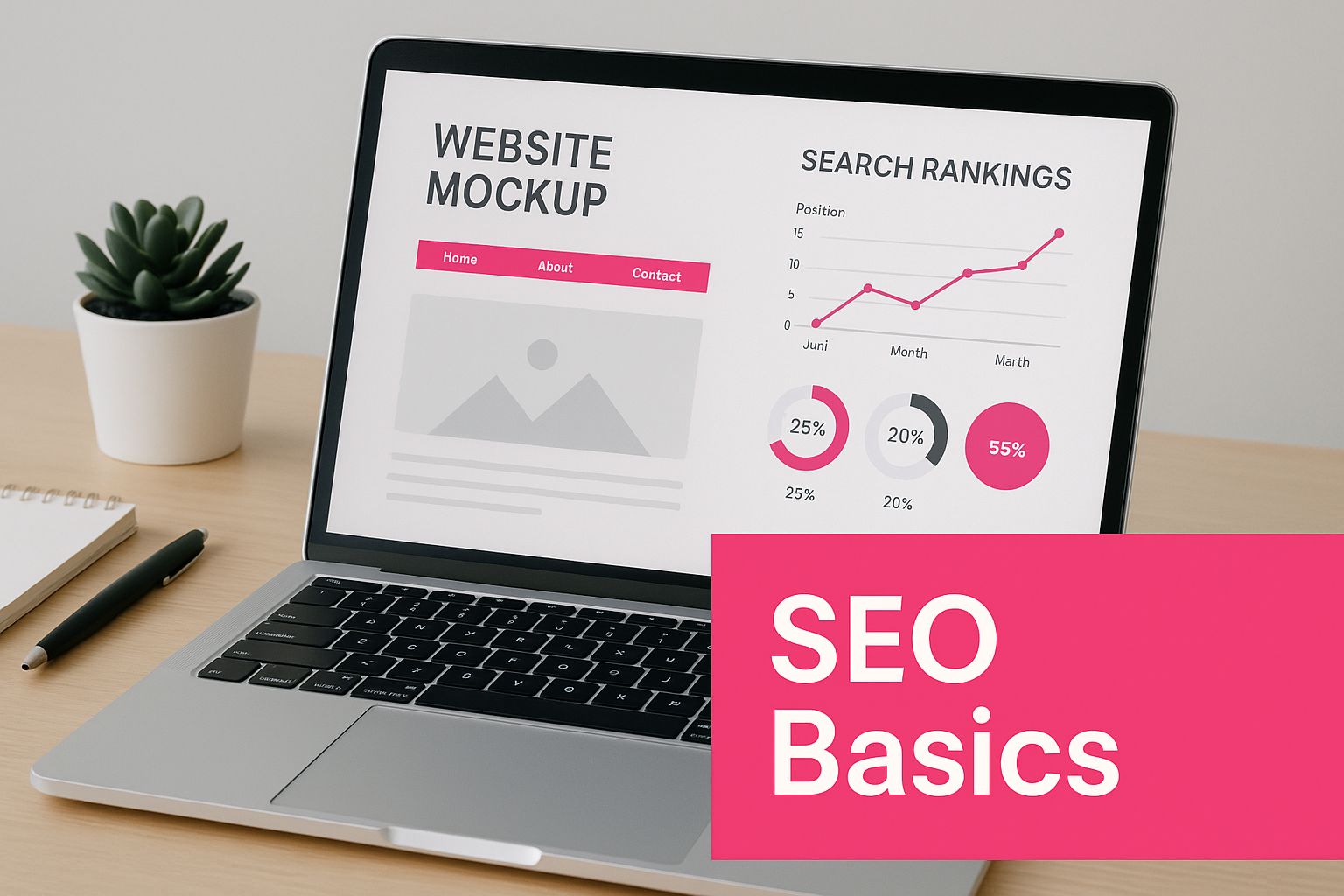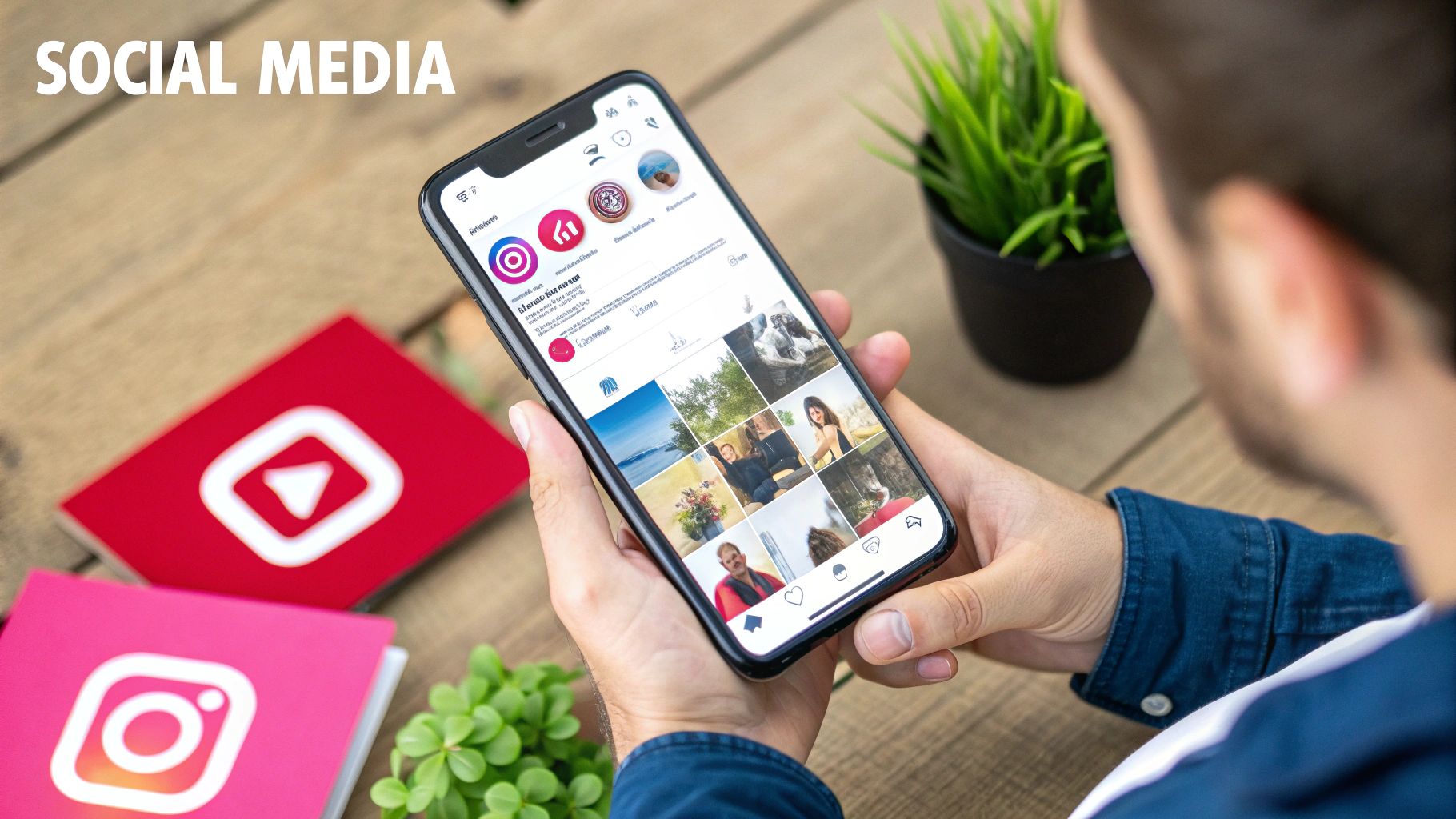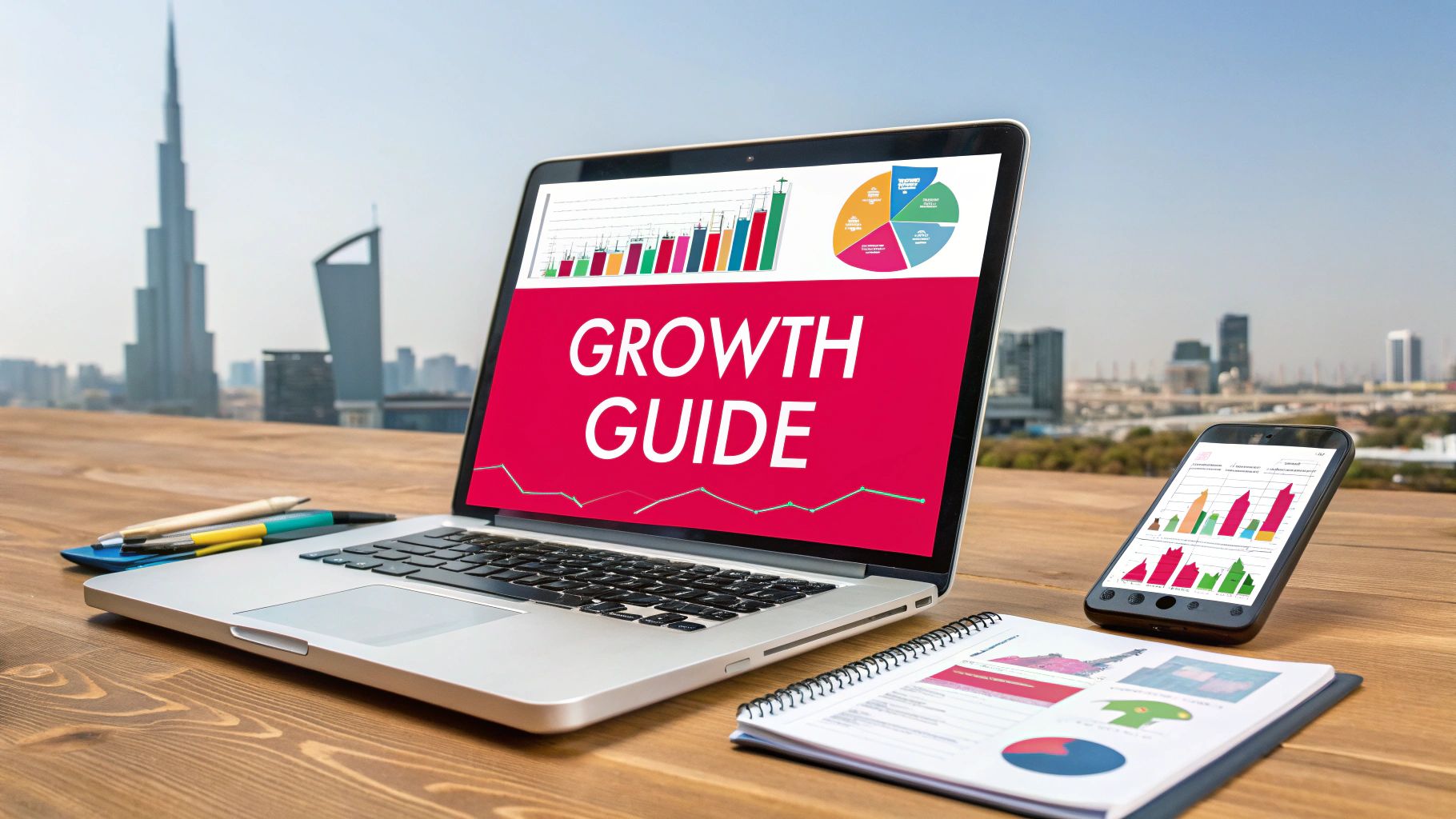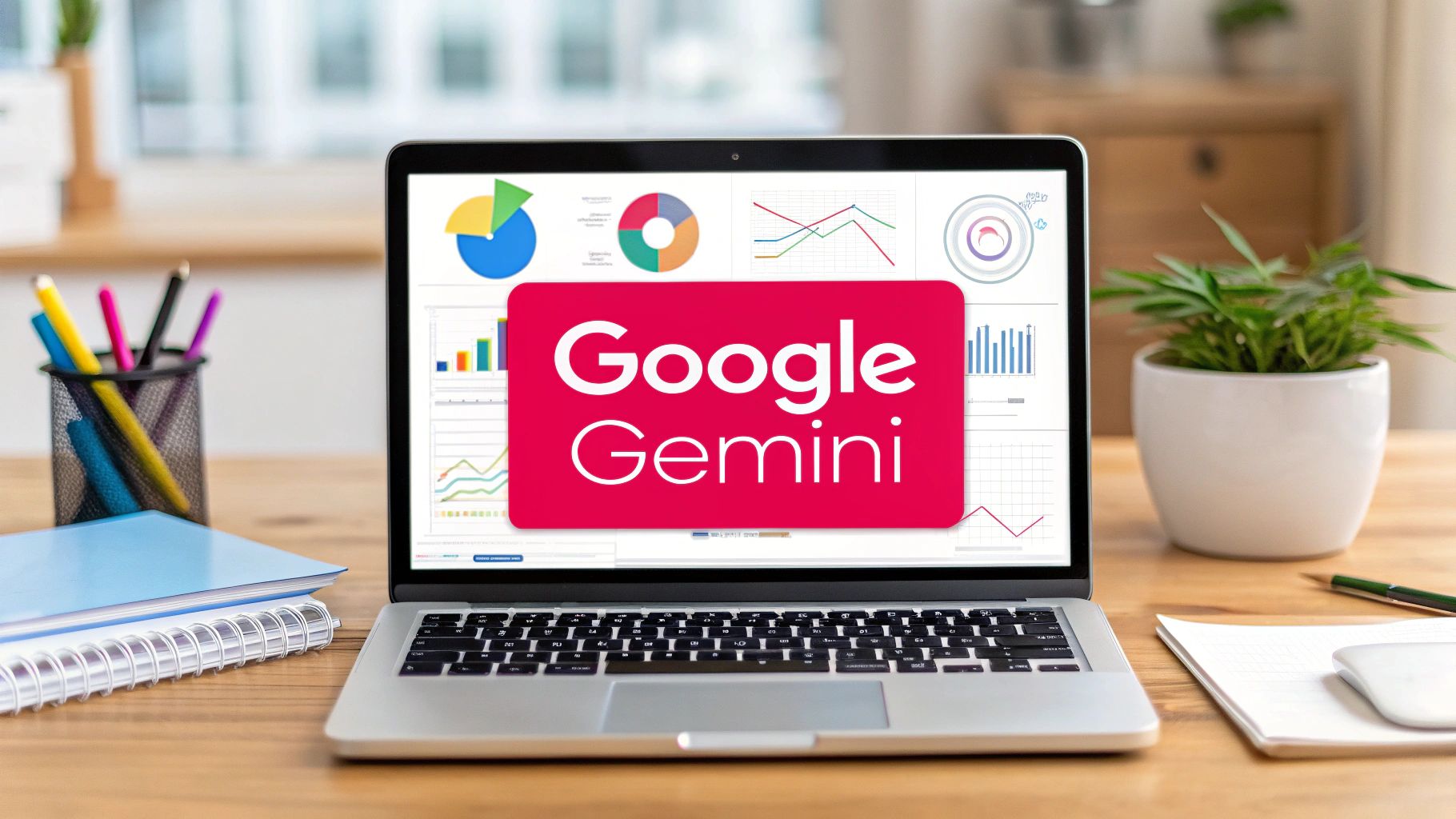Starting Your Digital Marketing Journey Without Breaking The Bank
Starting digital marketing can feel overwhelming for small businesses with limited budgets. Smart, strategic planning is key. Focus your efforts on channels offering the best return on investment (ROI). This requires understanding your ideal customer and their online behavior. Where do they spend their time? Are they on Instagram, engaging in online forums, or connecting on LinkedIn?
This targeted approach is much more effective than trying to be everywhere at once. It's about quality over quantity. A well-defined strategy allows you to allocate your resources effectively and see tangible results.
Setting Realistic Goals and Tracking Progress
Setting realistic goals is crucial. Don't aim for instant viral success, but instead focus on building a sustainable online presence. Set achievable milestones, like growing your email list by 10% monthly or increasing website traffic by 15% quarterly. Learn more about creating a digital marketing strategy. This measured approach allows you to track progress and adjust your strategy based on data.
Analyzing data is a cornerstone of successful digital marketing. You can gain valuable insights into what's working and what's not, allowing for continuous improvement and optimization.
The Growing Digital Landscape in the Middle East
The digital landscape in the Middle East offers significant potential. The digital advertising market in the MENA region generated USD 31,987.6 million in revenue. This signifies a promising environment for small businesses investing in digital marketing. Find more detailed statistics here. This growth emphasizes the importance of a strong and effective digital presence for businesses in the region.
Avoiding Costly Mistakes in Digital Marketing
One common mistake is spreading resources too thin across multiple platforms. This often leads to mediocre results. Instead, focus on one or two key channels initially. Master these before expanding. A focused approach allows you to build a solid foundation for your digital marketing efforts.
Building Momentum From Day One
Starting strong means prioritizing the fundamentals. Optimize your website for mobile devices, create engaging content, and build an email list. Learn more about mastering digital marketing. These core elements form the basis of any successful digital marketing strategy. They set the stage for sustainable growth and maximize your budget’s impact.
Mastering Mobile-First Strategies That Actually Convert
Mobile devices are deeply integrated into everyday life across the Middle East. This makes a mobile-first digital marketing strategy absolutely essential for small businesses operating in the region. Prioritizing the mobile experience is paramount when designing your website and crafting digital marketing campaigns. This means ensuring your website is responsive, adapting flawlessly to various screen sizes. Content should be easily digestible on smaller screens with clear calls to action, concise text, and intuitive navigation.
Optimizing for Mobile in the AE Region
Website loading speed is a critical factor, especially on mobile. Slow loading times can lead to high bounce rates, particularly where internet connections might be less stable. Ensure your website is easily navigable on a touchscreen. Simple changes like using oversized buttons and clear menus can significantly impact user experience.

The infographic above illustrates basic SEO principles, emphasizing the importance of mobile optimization and responsive web design. It highlights the synergy between SEO and a positive mobile user experience. These elements contribute directly to improved search rankings and greater user engagement.
The Power of Social Commerce
M-commerce, or mobile commerce, is increasingly important in the AE region. By 2024, smartphones commanded a 55.36% revenue share of the digital advertising market. Discover more insights about digital advertising market here. This underscores how effectively small businesses are using mobile platforms to connect with their target audience. Social media platforms like Instagram and Facebook aren't just for engagement anymore. They're powerful engines for driving direct sales through social commerce. This involves integrating shopping features directly into these platforms, enabling customers to browse and buy without leaving the app.
To help illustrate the effectiveness of different mobile marketing channels, take a look at the table below:
Mobile Marketing Channels Performance Comparison
Comparison of different mobile marketing channels showing engagement rates, cost per acquisition, and ROI for Middle Eastern small businesses
| Platform | Avg Engagement Rate | Cost Per Click | Best For Business Type |
|---|---|---|---|
| 1.60% | $0.50 – $3.00 | B2C, visually-driven products | |
| 0.80% | $0.50 – $2.00 | B2C, local businesses | |
| Google Search Ads | Varies, but generally lower engagement | $1.00 – $5.00 | Businesses targeting specific keywords |
This table offers a snapshot of how various platforms perform. Instagram generally boasts higher engagement, while Facebook offers broader reach. Google Search Ads are ideal for reaching customers actively searching for products or services.
Creating Compelling Mobile Experiences
Turning casual browsers into loyal customers requires compelling mobile experiences. Think about features like personalized recommendations, in-app messaging for customer support, and exclusive mobile-only offers. These can substantially boost conversion rates. For instance, a small business might offer a unique discount code to users who download their mobile app. This encourages downloads and incentivizes purchases. These targeted approaches can deliver a strong ROI and drive sales growth. A robust mobile strategy is not just recommended; it's a necessity for small businesses in the AE region wanting to thrive in today's competitive digital marketplace.
Creating Video Content That Stops The Scroll
Video content has become a cornerstone of how Middle Eastern consumers engage with brands. This presents a significant opportunity for small businesses to connect with their audience on a more personal level. It's not simply about following a trend; it's about using a powerful tool to build relationships and drive engagement. Whether through short, captivating social media clips or in-depth educational videos, the right video format can significantly benefit your business.

Crafting Compelling Video Content for Your Audience
Understanding your audience is paramount. Consider their interests and the challenges they face. Your videos should offer solutions, provide valuable insights, or simply entertain. For instance, a restaurant could create visually appealing videos showcasing daily specials or offering a behind-the-scenes look at their kitchen. A service-based business might produce short tutorial videos answering frequently asked customer questions. This targeted approach ensures your content resonates with the right people.
Video Production on a Budget
Creating high-quality video content doesn't require a massive budget. Plenty of affordable tools and resources are available for small businesses. Smartphones, paired with user-friendly video editing software like iMovie or Adobe Premiere Pro, can produce professional-looking results. Collaborating with local freelance videographers or film students can also provide cost-effective solutions. Prioritize clear messaging and engaging visuals over expensive equipment.
Planning and Distribution: Maximizing Your Reach
Consistency is key to successful video marketing. A content calendar allows you to plan and schedule video releases, ensuring a regular stream of content across various platforms. This also enables you to align videos with specific marketing campaigns or seasonal promotions. Distributing your videos across multiple channels, such as YouTube, Instagram, Facebook, and TikTok, maximizes your reach. This multi-platform approach ensures your content reaches a wider audience. Short, attention-grabbing videos are ideal for platforms like Instagram and TikTok, while longer, educational content thrives on YouTube. By 2025, video ad spend in MENA is projected to reach $2.8 billion, highlighting the growing importance of this medium. Explore this topic further.
Measuring Video Performance: Beyond Vanity Metrics
Tracking the right metrics is essential. While views are a basic indicator, metrics like watch time, engagement (likes, comments, shares), and click-through rates provide deeper insights. These metrics reveal how viewers are truly interacting with your content and how effectively it drives action. This data-driven approach allows you to refine your video strategy, concentrating on formats and topics that resonate most with your target audience. Understanding audience behavior and preferences is crucial for sustained success in small business digital marketing. This iterative process ensures your video content continues to improve and deliver results.
Building Social Media That Drives Real Business Results
Forget vanity metrics. Building a thriving social media presence for your small business in the AE region requires a strategic approach focused on tangible results. This means shifting from superficial numbers to genuine engagement and measurable outcomes. It also requires understanding the unique dynamics of social media in the Middle East and adapting your strategies accordingly. Let's explore how successful businesses are using social platforms to generate revenue and cultivate lasting customer relationships.
Creating Content That Sparks Meaningful Conversations
Creating content that resonates with your target audience is crucial. Instead of broadcasting promotional messages, focus on providing value and sparking genuine conversations. This involves crafting content that addresses the specific needs and interests of your audience in the AE region.
Consider incorporating culturally relevant themes, local insights, and user-generated content to foster a sense of community. This approach builds trust and strengthens connections with your audience.
Building Authentic Relationships With Your Audience
Building trust is paramount in the Middle East, and authenticity is key. Engage with your audience personally, respond to comments and messages promptly, and actively participate in relevant online communities.
This demonstrates a genuine interest in your audience and builds stronger relationships. For example, participating in industry discussions on platforms like LinkedIn or Twitter can establish your business as a thought leader and build credibility. Check out our guide on How to master social media management in Dubai. These efforts foster loyalty and ultimately drive sales.
Turning Followers Into Paying Customers
Turning followers into paying customers requires a strategic blend of organic engagement and targeted advertising. Utilize platform-specific features like Instagram Shopping or Facebook Ads to reach potential customers with tailored offers.
Also, leverage social media analytics to understand audience behavior and refine your campaigns for maximum impact. This data-driven approach allows for targeted advertising and personalized recommendations, significantly increasing conversion rates. This ultimately means focusing on strategies that directly contribute to your bottom line.
Platform-Specific Tactics and Content Planning
Different social media platforms cater to different audiences and require distinct strategies. Understanding these nuances is essential for effective digital marketing for small businesses. For example, visually-driven platforms like Instagram and Pinterest are excellent for showcasing products. LinkedIn, however, is more effective for B2B networking and thought leadership.
A well-structured content calendar helps maintain consistency and ensures your social media presence remains active and engaging. Time-saving tools and automation can help streamline these processes, allowing you to focus on creating high-quality content and building meaningful relationships. This strategic approach optimizes your efforts and generates real business results.
Using Data To Make Smarter Marketing Decisions
Data-driven decision making is the key to successful digital marketing. For small businesses in the AE region, where marketing budgets are often limited, using data effectively is even more critical. This section explores how small businesses can use analytics tools to understand their customers and improve their marketing performance.
Essential Metrics for Small Business Growth
Knowing which metrics to track can be overwhelming. Small businesses can gain valuable insights by focusing on a few key performance indicators (KPIs). These include website traffic, conversion rates, engagement metrics, such as likes, shares, and comments, and return on investment (ROI).
Tracking these metrics helps you understand how your audience interacts with your content and identify areas for improvement. For example, a high bounce rate on a landing page may indicate a problem with the page's design or messaging.
Tracking conversions, such as completed purchases or form submissions, helps you see which marketing activities directly impact your bottom line.
Understanding the relationship between these metrics can reveal significant opportunities for growth. For instance, combining conversion rate data with website traffic data can provide insight into which marketing channels bring in the most valuable leads.
To help illustrate the key metrics and their importance, the following table provides a concise overview:
Essential Digital Marketing Metrics For Small Businesses
Key performance indicators and analytics metrics that small businesses should track to measure digital marketing success
| Metric | What It Measures | Target Range | Tracking Tool |
|---|---|---|---|
| Website Traffic | Number of visitors to your website | Varies by industry and business goals | Google Analytics |
| Conversion Rate | Percentage of visitors who complete a desired action | 1-5% is a good starting point | Google Analytics, specific platform analytics (e.g., e-commerce platforms) |
| Engagement Metrics (likes, shares, comments) | Level of audience interaction with your content | Track growth over time, benchmark against competitors | Social media platform analytics (e.g., Facebook Insights, Twitter Analytics) |
| Return on Investment (ROI) | Profitability of your marketing campaigns | Positive ROI indicates campaign effectiveness | Marketing analytics platforms, custom ROI calculations |
This table highlights the essential metrics small businesses should focus on. Regularly monitoring these KPIs provides a clear picture of marketing performance and helps identify areas for optimization.
Practical Tools for Tracking and Analysis
Many user-friendly analytics tools are available for small businesses. Google Analytics is a free, powerful platform that provides extensive data on website traffic, user behavior, and conversions. Social media platforms offer built-in analytics dashboards with insights into post performance and audience demographics. These tools empower small businesses to gather crucial data without needing extensive technical expertise.

You might be interested in: How to master lead generation in Dubai.
Actionable Insights You Can Implement This Week
Interpreting data doesn't have to be complex. Start by identifying trends and patterns. For example, determine peak engagement times for your social media posts and identify which marketing channels drive the most valuable traffic to your website. By 2024, the digital marketing analytics market in the region was valued at USD 90.36 million, highlighting the increasing importance of data-driven strategies. Read the full research here. This underscores the importance of data-informed decisions, even for smaller businesses.
Using Data as Your Competitive Advantage
Data empowers you to make informed decisions about marketing budget allocation. By understanding which channels and campaigns deliver the best results, you can optimize spending and maximize ROI. This allows you to refine strategies, focus on what resonates with your audience, and achieve greater success with digital marketing for small businesses. This strategic approach transforms data into a powerful tool for growth.
Building A Marketing System That Grows With Your Business
Long-term success in digital marketing relies on more than just isolated victories. It requires a strategic system that can expand alongside your business. This system should consistently deliver results while remaining manageable within your available resources. This is particularly important for small businesses in the AE region facing a competitive market. Building such a system involves planning, quality control, and adaptability.
Frameworks For Planning Your Marketing Activities
A strong marketing system starts with a well-defined plan. This plan serves as a roadmap, guiding your activities and ensuring they align with your overall business goals. Consider using a framework like the SMART goals method (Specific, Measurable, Achievable, Relevant, Time-bound). This framework helps to clarify your goals, making them trackable and connected to your business vision. For instance, instead of aiming to "increase brand awareness," a SMART goal could be to "increase Instagram followers by 20% in the next quarter." This specific target allows for precise progress tracking.
Maintaining Quality While Scaling Your Efforts
As your business expands, upholding quality across your marketing activities can become more difficult. Documenting your processes is crucial. Create standardized procedures for content creation, social media posting, and email marketing to ensure consistency. This helps maintain a unified brand voice and messaging, even with team growth or outsourcing. Regular reviews and quality checks are also vital for identifying areas needing improvement. Think of it as a recipe: once you perfect it, you write down the steps to ensure consistent results.
Staying Competitive As Your Business Evolves
The digital marketing world is always changing. A successful marketing system needs flexibility and adaptability. This requires continuous learning and a willingness to try new strategies. Subscribe to industry blogs and publications, attend webinars, and participate in online communities to keep up with the latest trends in digital marketing for small businesses. Staying informed helps you recognize new opportunities and adapt your strategy as needed. For example, with the increasing popularity of video content, integrating video into your marketing mix might be a strategic move. By building a system that embraces change, you prepare your business for long-term growth and success in the ever-evolving world of digital marketing. This involves regularly revisiting your marketing plan, analyzing performance data, and making adjustments to stay ahead.
Key Takeaways For Digital Marketing Success
This section provides your action plan for implementing effective digital marketing strategies, complete with practical checklists and realistic benchmarks specifically designed for small businesses in the AE region. These actionable takeaways, inspired by the success of Middle Eastern businesses, can be put into practice immediately. Each point includes action items, realistic timelines, and measurable goals tailored to the constraints of a small business. You'll also discover helpful resources for tracking your progress, identifying potential roadblocks, and overcoming common digital marketing hurdles. The ultimate focus is on building sustainable momentum and achieving measurable results.
Mobile-First Mindset
In the AE region, mobile devices reign supreme. Therefore, ensuring your website is responsive is paramount. It needs to load quickly and be easily navigable on smaller screens.
- Action Item: Conduct a thorough mobile audit of your website. Pinpoint areas for improvement in loading speed, design, and overall user experience.
- Timeline: Complete this audit within the next week.
- Measurable Goal: Aim to decrease your mobile bounce rate by 5% within one month.
Video Content Strategy
Incorporate video into your content mix. Start with short, engaging videos and experiment with various formats to see what resonates with your audience.
- Action Item: Create one short video per week specifically for social media. Focus each video on a single tip, product highlight, or a behind-the-scenes glimpse into your business.
- Timeline: Begin video creation within the next two weeks.
- Measurable Goal: Strive to increase average video watch time by 10% within three months.
Social Media Engagement
Concentrate your efforts on the social media platforms where your target audience is most active. Focus on building authentic relationships with your followers.
- Action Item: Dedicate 30 minutes each day to actively engage with your followers on social media. Respond to comments and messages promptly and participate in relevant conversations.
- Timeline: Start implementing this immediately.
- Measurable Goal: Increase social media engagement (likes, shares, comments) by 15% within two months.
Data-Driven Decisions
Leverage free analytics tools like Google Analytics to gain valuable insights into customer behavior and measure your marketing performance.
- Action Item: Set up Google Analytics for your website and connect your social media channels.
- Timeline: Complete setup within one week.
- Measurable Goal: Identify your top-performing marketing channel based on conversion rates within one month.
Build a Scalable System
Develop a well-documented marketing system that can scale alongside your business growth. A key part of this system is creating a content calendar and standardizing your procedures.
- Action Item: Develop a basic content calendar for the next three months, outlining planned content for your chosen digital marketing channels.
- Timeline: Finalize your content calendar within the next two weeks.
- Measurable Goal: Aim to increase content output by 10% while maintaining consistent quality over three months.
Ready to elevate your digital marketing efforts? Grassroots Creative Agency, a Dubai-based digital marketing firm, specializes in creating bespoke strategies for businesses just like yours. We combine data-driven insights with compelling storytelling to help you achieve measurable results. Visit us to learn more and get started today.








